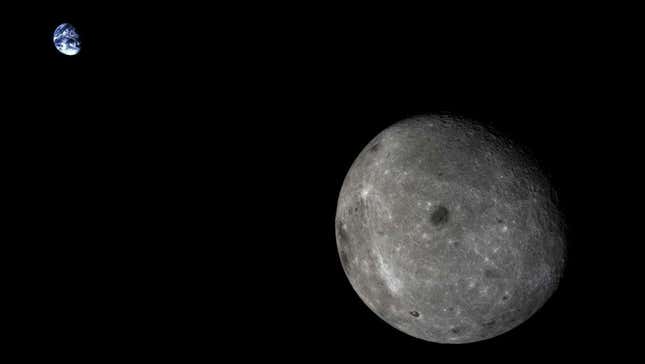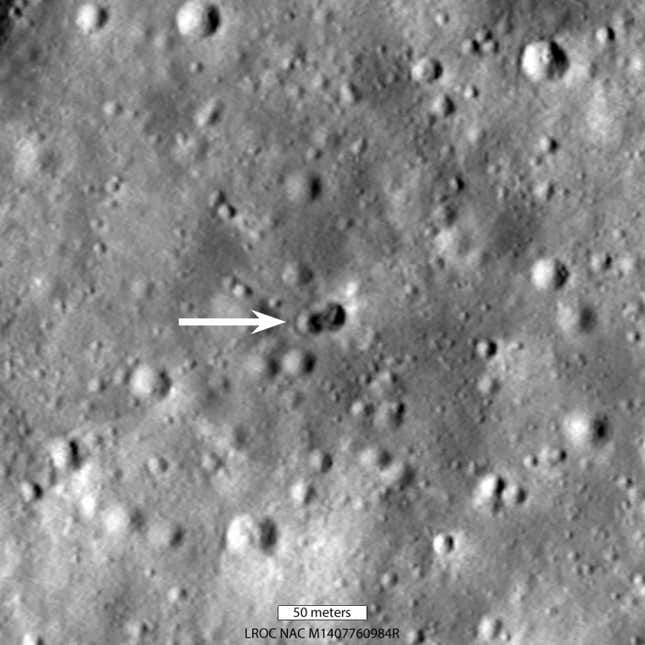
The surface of the Moon is littered with defunct hardware from past missions that are now buried amongst the lunar regolith. A recent crash site left a distinct and curious mark, creating two impact craters of equal size. Scientists examining the collision believe that there may have been an undisclosed object that crashed on the Moon, the origins of which will remain a mystery.
On March 4, 2022, a wayward rocket booster slammed onto the Moon’s surface. Prior to impact, it was believed to belong to a SpaceX Falcon 9 rocket that was left in high orbit in 2015, but further investigation revealed that it was actually a booster launched by China in 2014 as part of its lunar exploration program. That said, the space mystery continued as the booster created two craters upon impact, causing scientists to question what exactly crashed on the Moon that day.
Related article: Likely Crash Site of Mystery Space Junk Spotted on Moon’s Far Side
A group of researchers from the University of Arizona had been tracking the object’s trajectory for seven years prior to its unfortunate crash, as well as its impact site on the Moon. In a paper published Thursday in The Planetary Science Journal, researchers analyzed the rocket’s light reflection signature and its movement through space. Based on the observed characteristics, the researchers propose it was indeed a booster from China’s Chang’e 5-T1 mission, but one carrying a mystery payload that also met its demise on the lunar surface.

“This is the first time we see a double crater,” Tanner Campbell, a doctoral student at the University of Arizona, and lead author of the new study, said in a statement. “We know that in the case of Chang’e 5 T1, its impact was almost straight down, and to get those two craters of about the same size, you need two roughly equal masses that are apart from each other.”
The team of researchers behind the study were observing the skies to detect and study asteroids when they discovered an object speeding its way across the void of space between Earth and the Moon. Initially, the object’s identity was unknown, leading to its designation as WE0913A. As noted, it was first misidentified as a Falcon 9 rocket booster, but later confirmed to be from China’s Long March 3C rocket, launched for a future sample return mission test flight. The purpose of the booster was to propel its payload into its designated lunar orbit, and with its job complete, was left in space.
The researchers used a high-powered telescope to observe the booster and measured the changes in light reflection from it. This helped them track its movement as it traveled through its orbit. The booster, however, was behaving in an odd way. “Something that’s been in space as long as this is subjected to forces from the Earth’s and the Moon’s gravity and the light from the Sun,” Campbell explained. “So you would expect it to wobble a little bit, particularly when you consider that the rocket body is a big empty shell with a heavy engine on one side. But this was just tumbling end-over-end, in a very stable way.”
This led the researchers to believe that there was something else mounted to the front of the booster, serving as a counterweight to the two engines that served to keep it steady in orbit.
Following its crash on the Moon, the researchers also observed the two impact craters which provided further evidence to their theory. “Obviously, we have no idea what it might have been – perhaps some extra support structure, or additional instrumentation, or something else,” Campbell said. “We probably won’t ever know.”
China often keeps details of its missions confidential, so it is unsurprising that the booster carried a mystery object and that the Chinese space agency has not disclosed its nature. As more missions are planned for the Moon, however, it is probably wise to advocate for more transparency when it comes to the objects that the various space agencies and industry leaders want to put on the Moon.
For more spaceflight in your life, follow us on X (formerly Twitter) and bookmark Gizmodo’s dedicated Spaceflight page.